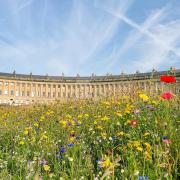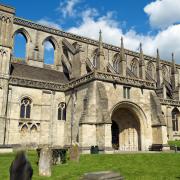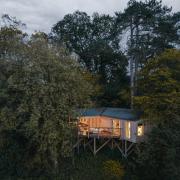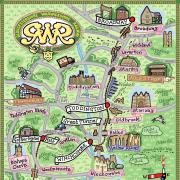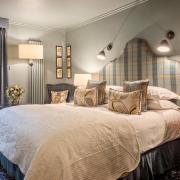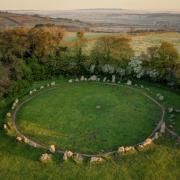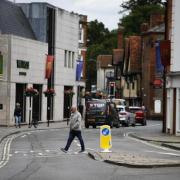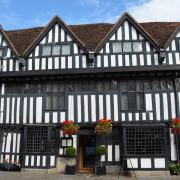A breath-taking celebration of colour, mark making, tremendous skill and composition is currently taking place in Moreton-in-Marsh. It is the Summer Exhibition of John Davies Gallery and features more than 100 paintings from top-end artists who are all masters in their own discipline.
Whilst representing different styles and approaches, each painting marks a moment in time and a significant place or object, captured by the artist in his or her unique way.
During my latest visit to this historic market town, I challenged local traders to suggest what type of painting they believe portrays Moreton’s character. I will reveal their thoughts and ideas shortly. But first I will set the scene by looking at the work of artists in the John Davies Gallery, based on the Fosseway Business Park, who demonstrate how colours and compositions are put together.

The Summer Exhibition is carefully curated to ensure balance and rhythm so that the eclectic mix of oils, mixed media, acrylic, graphic and more sculptural substrates work well together. Although the artists may not have met in person, their masterpieces sit comfortably side by side, silently complementing one another to provide a rich narrative which celebrates creation in all its forms through atmospheric seascapes, landscapes, and still life compositions.
Oxfordshire-born Neil Canning’s abstract work, which encompasses fluent and gestural mark making and vivid yet sensitive colour, is inspired by the landscape of Cornwall. Awarded an Honorary Doctorate from the University of Exeter, Neil has been closely associated with the ‘new’ generation of St Ives artists. His mixed media work ‘Lunar,’ involving a limit palette of luminous yellow, blue, and white was created with the canvas in both a vertical and horizontal position, so there are poignant paint drips, yet a complete circle within the composition.

Entering The John Davies Gallery, one is transported into another world. Each painting sings a different song, and will appeal to onlookers on different levels, touching emotions, evoking memories, and reaching in ways words cannot. Personally, I come away inspired yet moved and reminded how powerful art is and how much it adds to our lives.
As a musician and composer, it is no coincidence that Dr Marc Yeats’ paintings have an almost symphonic tone to them. There is orchestral energy as his fantastic mark making and abstract overtones come together in a harmonious way. In May, the BBC Scottish Symphony Orchestra premiered a big orchestral piece of his called ‘A Point in the Landscape,’ as part of Tectonics Glasgow 2024. His painting compositions are representations of landscape, painted from drawings made on the spot in various parts of south and eastern England.
In contrast, the powerful landscapes of David Tress, show a physical approach, akin to action painting. This is demonstrated by paper layering and broad mark-making, leaving a contoured, three-dimensional, and sculptural impression. Last year David took the decision to lay down his paintbrushes in favour of writing, marking an end to a 40-year career as a prolific painter.
Within the Summer Exhibition, two paintings have a magnetic pull for me personally. The first is Nick Heap’s ‘Three Pools,’ a semi-abstract depicting, as the title suggests, three pools enveloped in a rich tapestry of colourful squares and marks which almost dance in celebration around the three mauve ovals. It is as if the vibrant oils are hosting a party.
The other composition that resonates is Peter Graham’s ‘Cassis Roses’, perhaps due to his joyful vibrant approach, where colours combine and seem to pop and speak ‘behold me.’
Gallery owner John Davies has spent a lifetime appreciating art. For the past five decades he has provided a platform for highly respected artists to show their work.
It was during lockdown, that he found the time to pick up his paintbrushes and paint again.
‘I have been in the business 50 years. I came into the industry intending to be an artist myself, but it is only since lockdown that I have been doing my own work again,’ says John.
For 30 years John had a gallery in Stow-on-the-Wold which specialised in 19th century and early 20th century. He relocated his business to Moreton in Marsh when he saw potential in the former pasteurisation plant as the ideal space for his gallery. He now shows the work of 20th and 21st century artists.

Hidden walks
As I leave his gallery, I ask him what painting he thinks best portrays Moreton-in-Marsh. As a resident here, he knows the places that visitors don’t often see unless they stumble on them by chance. And, being an artist, he can even provide evidence of his favourite spots.
‘Moreton has some lovely country walks set out of the town. On the west side and the east side, you can walk straight into the countryside. There are marsh areas, that are lush and beautiful. I enjoy the hidden gems like the Lemington Lakes,’ says John, who exhibited at the Royal Academy in 1975.
‘My work is high naturalism and I do work locally. I love orchards. I draw in situ and takes lots of notes and then paint into the drawing’s surface in my studio, whilst listening to Radio 3, which I also play in the gallery.’
So, painting number one depicts the hidden walks of Moreton. It is represented by a watercolour, painted by John called ‘Reflections at Lemington Lakes, Moreton-in-Marsh,’ showing a picturesque spot that visitors do not have access to. The lakes are only open to fishermen who are members. For those who enjoy walking, there is incidentally a circular walk from Moreton-in-Marsh, which takes in the Monarch's Way and the Heart of England Way to explore the countryside, villages and woodland surrounding the popular Cotswolds town.

Tuesday is Market Day
Painting number two comes from Londoner Kelly Dixon, who is the proud owner of award-winning Grouch Café, which opens during the week at 6.30am much to the joy of early commuters. A baker’s daughter, Kelly has been baking since she was tiny, and her mouth-watering brownies are the ideal companion to her great coffees. Her business began during the pandemic, selling coffee from a three-wheeled Tuk Tuk Piaggio Ape at Kingham Railway Station, before she moved it to Moreton Railway Station. She has been in her much-loved café on New Road for three years. I was privileged to award her first prize for her coffee shop in the Cotswold Life Food and Drink Awards, (taking place on October, 7 this year) and I stand by that decision. Kelly offers more than amazing coffee; she offers a special vibe and community buzz. So, what would be her painting offering in my hypothetical gallery on Moreton?

‘I think it would have to be a summer market scene with all the traders out, an atmosphere of hustle and bustle, people smiling and walking along with a drink from a local trader and some delicious food from another local business. Tuesdays in Morton-in-Marsh are the best,’ she admits.
Moreton’s Tuesday market takes place from 9am until 3pm and is apparently the largest street market in the Cotswolds with many stalls selling virtually anything. This includes leather goods, purses, books, fish, produce, pet products, clothing, and cookware. An original market charter was granted in 1629. One fun landmark to look out for in Moreton, is a plaque showing ‘The Undermentioned Tolls,’ detailing the charges made on market, fair and other days including what price folk had to pay to hold a coconut shoot, waggon, or hand cart. The modern-day markets were set up in 1976 by Cotswold Markets.

A Royal Portrait
The third painting in my gallery is a Royal one and is a portrait of King Charles I. It acts as a reminder that Moreton-in-Marsh is excellent at hospitality and has entertained the rich and famous, as well as royalty.
The White Hart Royal Hotel and Eatery is an historic royalist hotel in the High Street, where King Charles I stayed twice, so say on July 2, 1644, and August 30, 1645. On one of those occasions, he did not pay his bill apparently. But this hotel also contains evidence of something more sinister – Charles I’s death warrant.

‘As the King apparently didn’t pay his bill, we probably need to add a royal portrait in the mix, so the painting added to the Moreton Gallery would have to be a portrait of a king,’ says Kate Ramsey, duty manager.
JRR Tolkien also stayed here, either in room 104 or 108, which leads to the next painting celebrating Moreton-in-Marsh, highlighting the mythical creatures dreamed up by this famous author.

Hobbit houses
The Bell Inn, along with other landmarks near Moreton, notably the Four Shire Stone, and indeed the town itself, known as Bree to Tolkien fans, play a huge part in Tolkien’s imaginary world. The 9ft 16th century pillar is thought to be the inspiration for the Three Farthing Stone in the Lord of the Rings. The Bell Inn is known as The Prancing Pony in his famous trilogy and Tolkien fans world-wide often visit or stay at the pub, just to say they have seen the place which inspired the one visited by Bilbo Baggins and his friends. A huge map on the pub wall shows Middle Earth. Look closely and the word Bree can be spotted, which is the fictional name for Moreton-in-Marsh. This pub is also where Tolkien used to meet up with his brother Hilary. So, the fourth painting is rather fitting, offered by bar tender Grace Ralley.
‘I think The Bell represents a narrow road with lots of Hobbit houses, perhaps with Bilbo dancing on a table. So, I think that is what the painting should show,’ she says.

Say, Cheese!
The reference to Bree provides the perfect link to another brie. This can be found at the Cotswold Cheese Company in the High Street. In the John Davies Gallery’s Summer Exhibition are oil paintings on linen by Raquel Alvarez Sardina that are so realistic one can almost reach out and grab hold of the lemons and quince she has painted. But even if Raquel painted the amazing assortment of cheese on display in Moreton’s popular cheese shop, there is something that a painting cannot do. It cannot capture the sensation of smell, something that comes hand in hand with entering this place. So jokingly I suggest that perhaps their offering could be in the form of a Scratch and Sniff painting, so the rich pungent aroma of the blue cheeses, in particular Stinking Bishop, can come to life. Shop manager Heidi Greene agrees. As we chat, the idea is cemented as Heidi’s colleague asks a gentleman visiting from Washington, USA, who is observing the cheese: ‘Can I help you?’ His reply is this: ‘No thank you, just smelling!’
The cheeses here are mini portraits, encased in rind, or skin – some with edible petals and herbs, others soaked in perry or wine – but they are aromatic and need to be smelt. It is not enough to see them on a painting, they must be smelt and tasted.
The ‘paintings’ names are potentially fantastic too. ‘Baron Bigod’ is perhaps my favourite.
‘Bigod implies ‘by God that’s good cheese!’ It’s an English brie made in Suffolk and probably the most mispronounced cheese in the counter,’ says Heidi.

Busy and lively
The sixth Moreton painting moves from smell to action. It comes from staff at Otis & Belle, an artisan bakery famous for sourdough and cinnamon buns, although I notice other delights such as pear tart, chocolate tiffin and chocolate fudge cake. Imogen Fellows, who works here, offers a painting suggestion.
‘I think it would be a still life of pastries, full of colour, with lots of cars, capturing the lively, busy, colourful nature of Moreton, with people coming and going,’ says Imogen.
Meanwhile, Cindy Bramley from Jacana Ladieswear, which sells clothing accessories, handbags, scarfs, jewellery, and unusual garden ornaments including metal herons and peacocks, has a more serene idea.

‘I think the painting would have to be garden, full of flowers and lots of colour,’ she says.
Other paintings reflecting Moreton’s treasures could be the trees of Batsford Arboretum or metal birds of flight with Wellington Aviation, or natural birds of flight as a nod to the Cotswold Falconry Centre. But before I leave, it is a Tracy custom when I visit Moreton-in-Marsh, to have a ride on Queen Victoria Gardens’ zip wire. As I do so, a gentleman shouts out to Meg: ‘Isn’t she too old for that?’
Just as we can never tire at looking at and appreciating art, we should never stop enjoying the playful and creative things of life. Otherwise, the Hobbits would not have visited Bree or have enjoyed The Prancing Pony. I am sure Tolkien would agree.
johndaviesgallery.com






